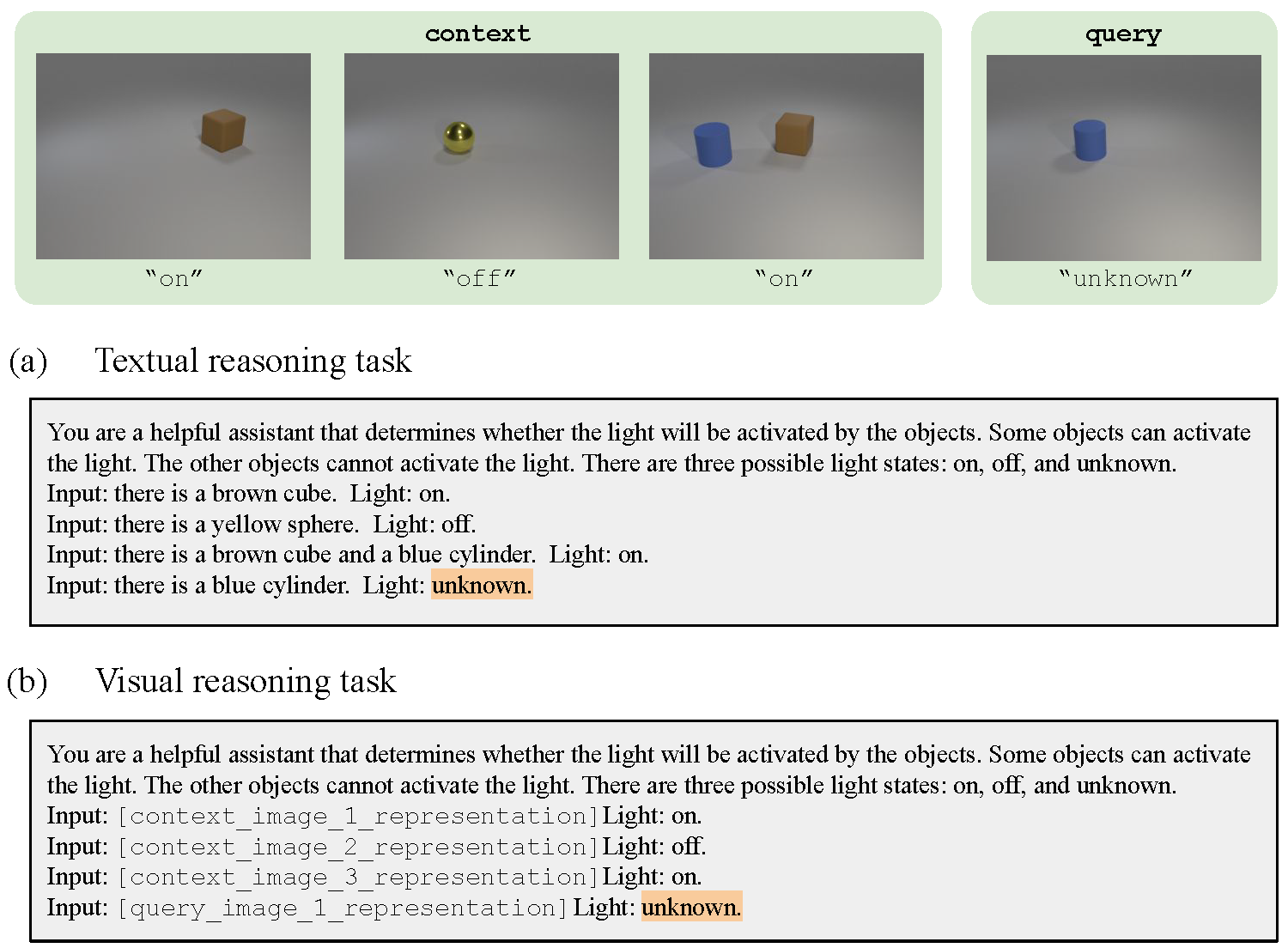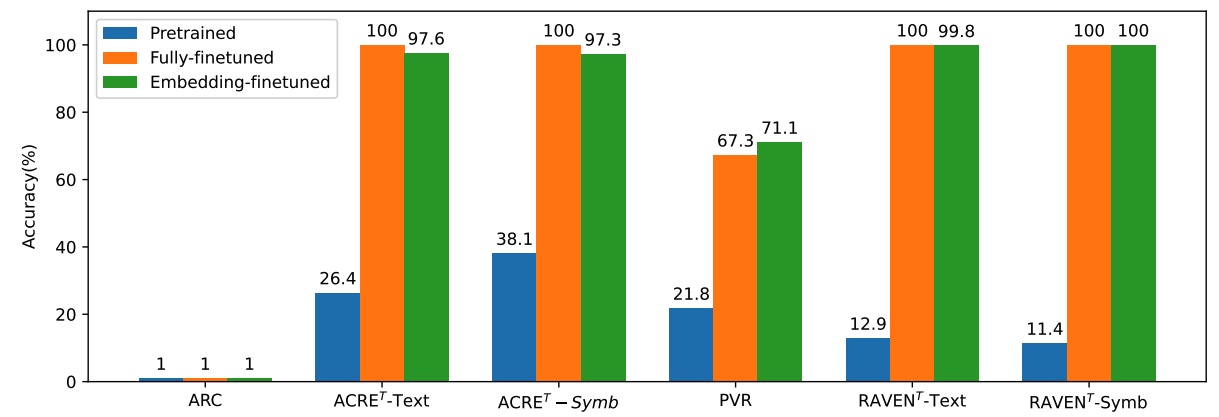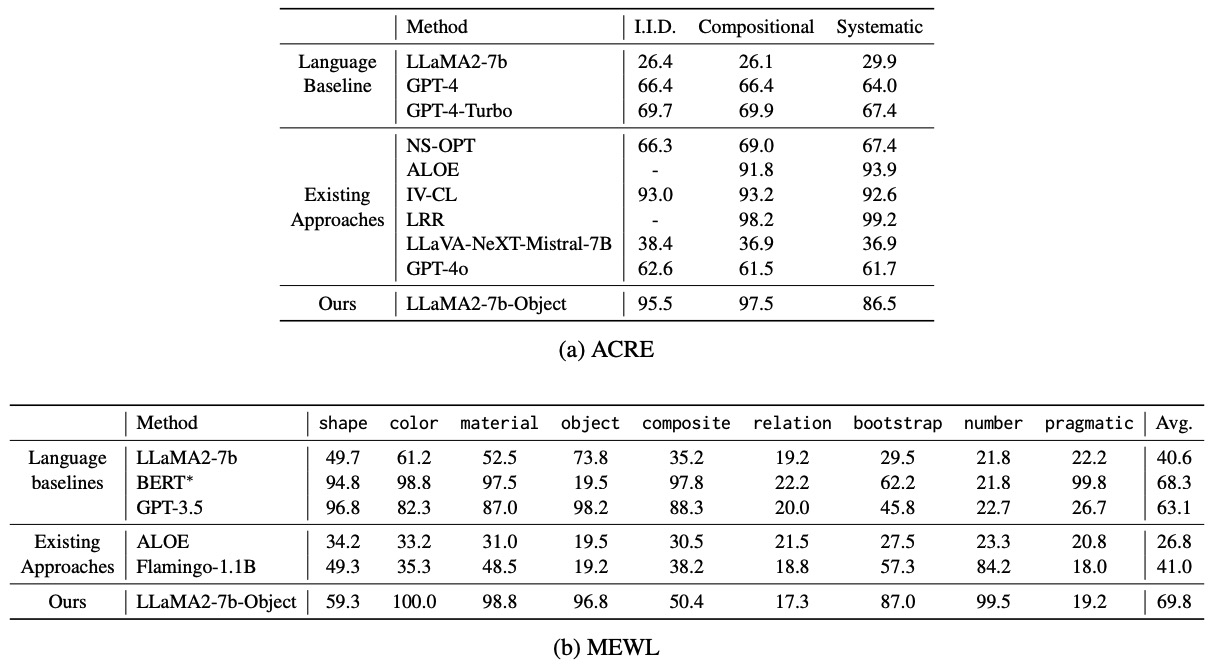The question of whether LLMs are abstract reasoners has consequences for how we understand and thus how we develop increasingly advanced artificial intelligence. The challenge is that there is no consensus for what it means to be an abstract reasoner. In their recent work, Gendron et al operationalize abstract reasoning as the ability to transfer zero-shot to a range of complex reasoning tasks. They find that LLMs perform poorly on this evaluation, and thus conclude that they are not abstract reasoners.
In this work, we reproduce Gendron et al's findings, but push back against their interpretation. In particular, we provide new experiments which show that tuning just the embedding layer is remarkably effective. Indeed, across a variety of textual and multimodal tasks, frozen pretrained LLMs can achieve high levels of performance as long as the input representations are adapted sufficiently for each task.
It seems too stringent a criteria to require that that abstract reasoners perform arbitrary tasks on arbitrary inputs without adaptation. By way of counterargument, consider the good old fashioned AI (GOFAI) systems of the 1990s, which typically included symbolic systems internally, e.g., databases implemented in SQL or rules for logical inference implemented in PROLOG. By most intuitive definitions, these databases and rules would be considered "abstract" and the tasks the systems performed over them would be "reasoning". But we would not expect these systems to operate well over a database implemented in MongoDB, or to apply rules defined by Python. Rather, the need to operate on representations of a particular format is a consequence of, not an exception to, the system's abstraction.
Of course, we don't claim that the internal processing of an LLM is exactly analogous to that of a GOFAI system. Of course, in an LLM, tuning the input embedding layer might do more than simply "rerepresent", but rather might encode some task-specific processing as well. But interpreted loosely, the analogy is useful for highlighting how the question of adaptability and transferability relates to the question of abstraction and reasoning.
Indeed, this relationship has been considered in depth by philosophers of AI, long before LLMs. For example, Dennett appeals to transferability in his attempt to describe the difference between human cognition and simpler computational systems:
Consider the lowly thermostat...we might agree to grant it the capacity for about half a dozen different beliefs...it can believe the room is too cold or too hot, that the boiler is on or off...and so forth...suppose we de-interpret its beliefs and desires, it can believe the A is too F or G...and so forth....by attaching the thermostatic control mechanism to different input and output devices, it could be made to regulate the amount of water in a tank, or the speed of a train for instance...But as systems become perceptually richer and behaviorally more versatile, it becomes harder and harder to make substitutions in the actual links of the system to the world without changing the organization of the system itself.
...There comes to be a two-way constraint of growing specificity between the device and the environment. Fix the device in any one state and it demands a very specific environment in which to operate properly (you can no longer switch it easily from regulating temperature to regulating speed or anything else); but at the same time, if you do not fix the state it is in, but just plunk it down in a changed environment, its sensory attachments will be sensitive and discriminative enough to respond appropriately to the change...
Although Dennett is not discussing the notion of "abstract reasoners" per se, he observes that intelligent systems do not transfer well unless they are allowed to adapt. Indeed, Dennett argues that this is a defining property, one that differentiates human-like intelligence from simpler (albeit perhaps more abstract) systems such as thermostats.
Dennett's argument is relevant here not because LLMs are human-like or even human-level in their reasoning abilities (they are far from it!). Rather, Dennett articulates a position that is implicit in contemporary discussions about LLMs and "abstract reasoning". That is, that we care about how well a system adapts to new environments because adapting well to new environments is a hallmark of intelligence. Indeed, this is often cited explicitly as the motivation for studies of this nature (e.g., "the question of whether or not LLMs can perform human-like reasoning remains open..." (Gendron et al. 2024)). But if evaluating human-likeness or human-levelness is the motivation for studying abstract reasoning, then arguments such as Dennett's provide a compelling case against using zero-shot transfer ability as a relevant metric.
Of course, there is another, more practical, argument for why we might care about whether LLMs are abstract reasoners, which is simply that we want LLMs to transfer well zero-shot to many tasks in order to facilitate easier, cheaper, and more efficient development of systems. Indeed, the thermostat's highly abstract design is a feature, not a bug. This type of hardware abstraction is what allows similar components and control mechanisms to be readily repurposed to support many types of use cases. A "human like" thermostat might be very undesirable.
Thus, before seeking to answer the question of whether LLMs are "abstract reasoners", we must first determine, as a community, why we care. Do we care because we want to understand how human-like they are, or do we care because we want to facilitate more efficient technological progress? Almost certainly, we care about both, but we should not expect the same experiments to bear on both lines of inquiry. Finding clarity around these questions - what is an abstract reasoner and why do we care about building one? - is the essential next step if we are to make progress toward either, or both, goals.
|






